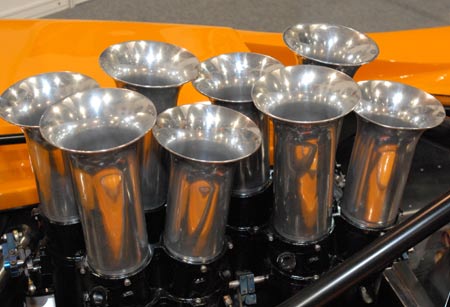Variable intake
The CAN-AM series of the late 1960s and early '70s made a big impression on a younger me, and may in part have kindled my passion for high-performance engines. An 8.1 litre Oldsmobile unit on the dynamometer test stand at Imperial College London and its thunderous roar as it fired into life was one of those evocative sights that has remained with me for more than 40 years. But apart from the sight and the sound of it all - and the stream of huge sparks coming from the electric starter motor as it cranked the high-compression engine into life - the most notable memory is that of an array of different length intake trumpets as they sprouted from between the cylinder heads.
At the time, the reason given for this practice was to even out the torque curve such that each cylinder would hit its resonant cylinder-filling frequency at a slightly differing speed and, by manipulating the torque curve, enable the driver to cope with the huge torques generated by the monstrous engine. How effective all this was is never recorded, but it is interesting to note that to my knowledge no-one ever copied this approach.
These days of course we have aerodynamics and downforce on the cars, and therefore more grip than the CAN-AM cars of the period, and are better placed to manipulate the torque curve by altering the ignition timing and fuelling by electronic means. Controlling the rate at which the torque comes in at the rear wheels is therefore not such a tribulation as it once was, and in the final analysis, if the regulations allow, we always have traction control.
But simply altering the fuelling and ignition timing to change the engine performance curve always somehow seems wrong, and is a last resort to many a power unit engineer, since moving away from the optimum efficiency is alien to our way of thinking. As a better way to change the shape of the torque curve and keep the cylinders working at their optimum, the use a variable intake manifold technology might be a better approach.
This can take many forms. In engines with plenum chambers fed by a single throttle plate/airflow meter, this can be simply a system of flap valves opening and closing either an aperture to vary the effective length of the intake runner or altering the resonant behaviour of the intake system, much like a Helmholtz resonator. These are in general not infinitely variable but simply two- or three-position devices that optimise the system at different speeds. While highly effective though, they are still compromised away from those speeds.
In competition engines with open intakes, the most effective method is the telescopic intake port, which not only alters the length of the intake runner but does so in a continuous way so that the engine can be optimised for wide-open throttle performance at all engine speeds. I once saw a system (now banned in Formula One) that amounted to a tube sliding within another operated by some form of stepper motor controlled by the engine ECU. An ingenious approach, not necessarily unique but one that was never to see the light of day, since the authorities outlawed such systems the following year.
I remember talking to the system's designer, who told me candidly that the method worked well at constant speed but suffered from a transient issue, although not in the speed of the motor and its ability to respond to the rapidly changing rpm of the engine. No, the major issue was to do with fuelling. Injected centrally into the intake port at the entrance to the intake runner, some of the fuel would attach itself to the runner wall. However, as the engine speed rose and the port collapsed, that fuel was effectively scraped off and introduced back into the airstream, upsetting the carefully calculated air-fuel ratio. Not an insurmountable problem but one that needed time to model and compensate for in the fuelling system.
As an engineer, this was all very interesting but somehow not as evocative as the sight of that CAN-AM engine over 40 years ago.

Fig. 1 - Such sweet music
Written by John Coxon